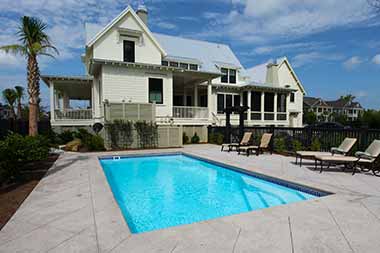Toledo, Ohio swimming pool contractors from Bella Blue Pools spend time answering the question of how to clean your swimming pool when they pay service visits. Owning a swimming pool or spa can be confusing and time-consuming if you don’t know what you’re doing.
Swimming pool owners also deal with the balancing act of not having a lot of free time and knowing they’d rather swim in that free time instead of clean the swimming pool, right? Even if you hire a swimming pool service contractor to take on the task of pool cleaning, it’s always good to know the ins and outs of pool maintenance.
You should know enough about how to clean your swimming pool so you can recognize if something is going awry or if you need to clean between a service visit or even if you decide to take on the entire cleaning role on your own. Note: many pool owners find it is more cost effective to hire a pool professional than to care for the pool themselves.
How To Clean Your Swimming Pool
We have put together a short list of pool cleaning tasks that we perform for our customers and those that you could do on your own.
- Invest in a swimming pool cover. This should be considered a necessity rather than an accessory. A cover reduces overall maintenance costs, saving on chemical use and heating. A cover reduces evaporation and acts as an additional safety barrier to keep children and pets from falling into the water. You may want to talk with your pool contractor about getting a retractable pool cover because that will help assure you’re diligent in its use.
- Write the correct operating pressure on the pool filter. You or your pool contractor should do that as a way to make note of the proper pressure. A reading above or below that reading could mean there is a potential equipment issue.
- Keep all manuals and operating instructions in an easily accessible location. There are times when you might think there is a major problem with the timers when it could merely be a matter of needing to be reprogrammed.
- Test the pool water chemistry frequently. Invest in a high quality water test kit and ask us how to interpret the readings so you know whether you need to add chemicals and if so, which ones.
- Brush the walls and pool floor. Pay attention to nooks and crannies — like behind swimming pool steps — as algae can grow in those spaces.
- Vacuum the pool after you’ve brushed it. The correct way to vacuum the pool is to work slowly around the pool or spa. Work down the walls and along the floor. Take your time because if you move quickly you will simply stir up the dirt, making it harder to remove. Ask us about robotic pool cleaners as a way to make this task easier.
- Talk to your contractor about installing your skimmer on the downwind side of your swimming pool. This uses the power of the wind to push debris toward the opening and cut down on cleaning time.
- When you’re adding chemicals, add them a little at a time – this is especially true when it comes to balancing the chemicals in a spa.
- Add chemicals at night to help alleviate the evaporation of the chemicals.
- Run the pool pump for the recommended number of hours. That number is different based on the size of your swimming pool, but plan to run it about eight to ten hours per day.
There are maintenance steps pool owners can easily do between scheduled service visits to keep the water clean and swimmable. At the very least you need to skim leaves and debris from the pool. It’s always best to scoop out debris before it falls to the bottom of the pool.
If you are a new pool owner or are looking for ways to have a more eco-friendly swimming pool give us a call. We have been working diligently during the coronavirus pandemic to keep our customer’s pools clean and ready to be used.

